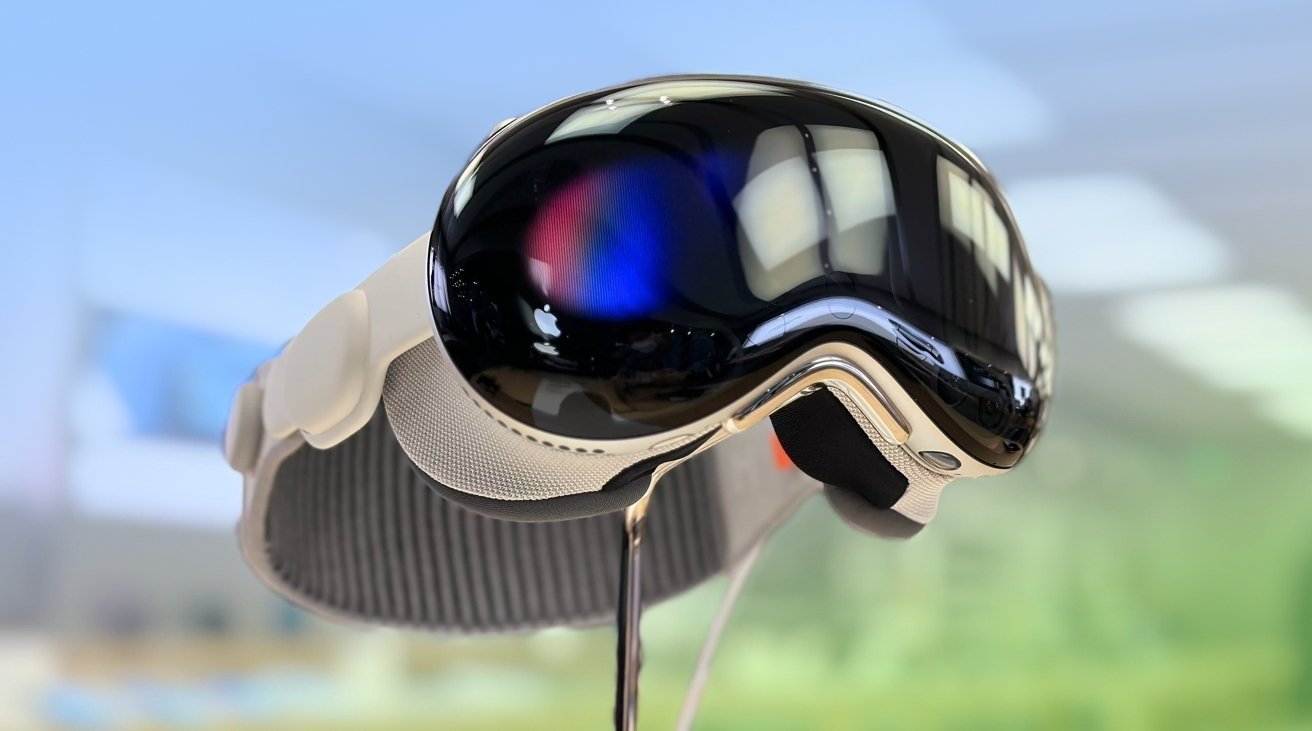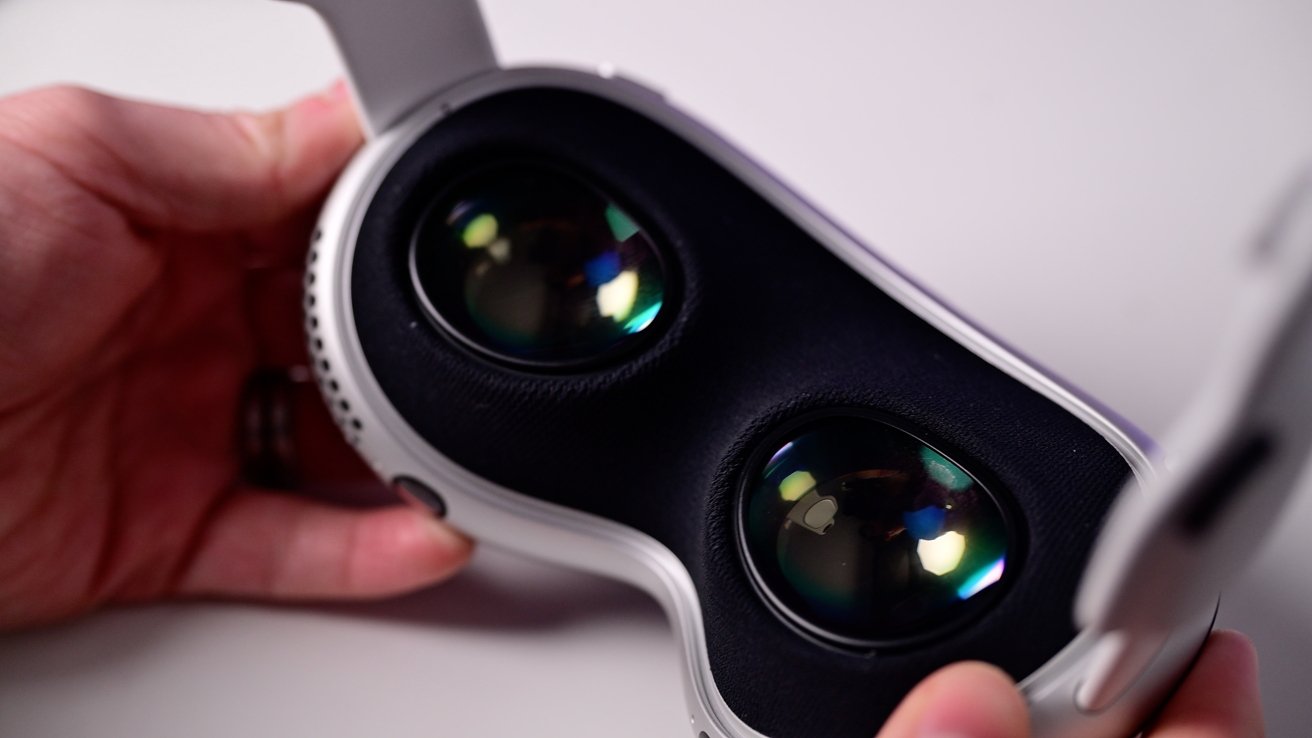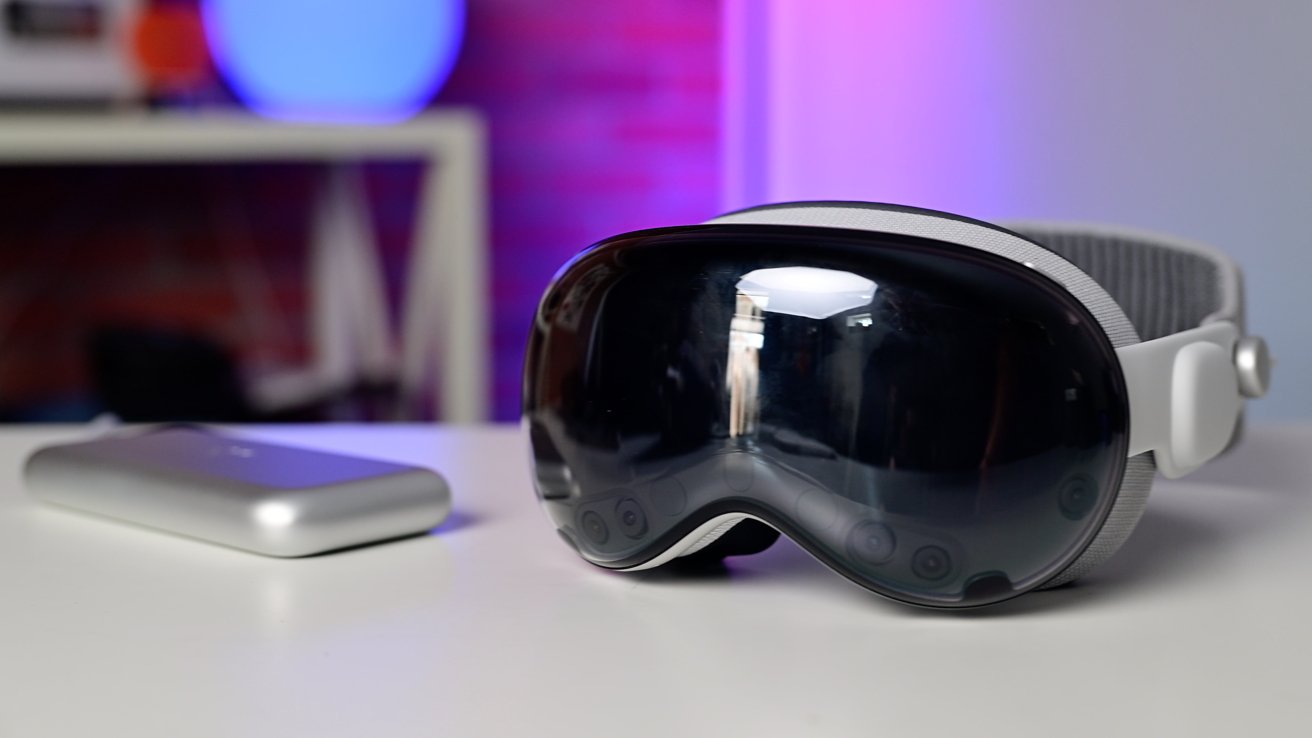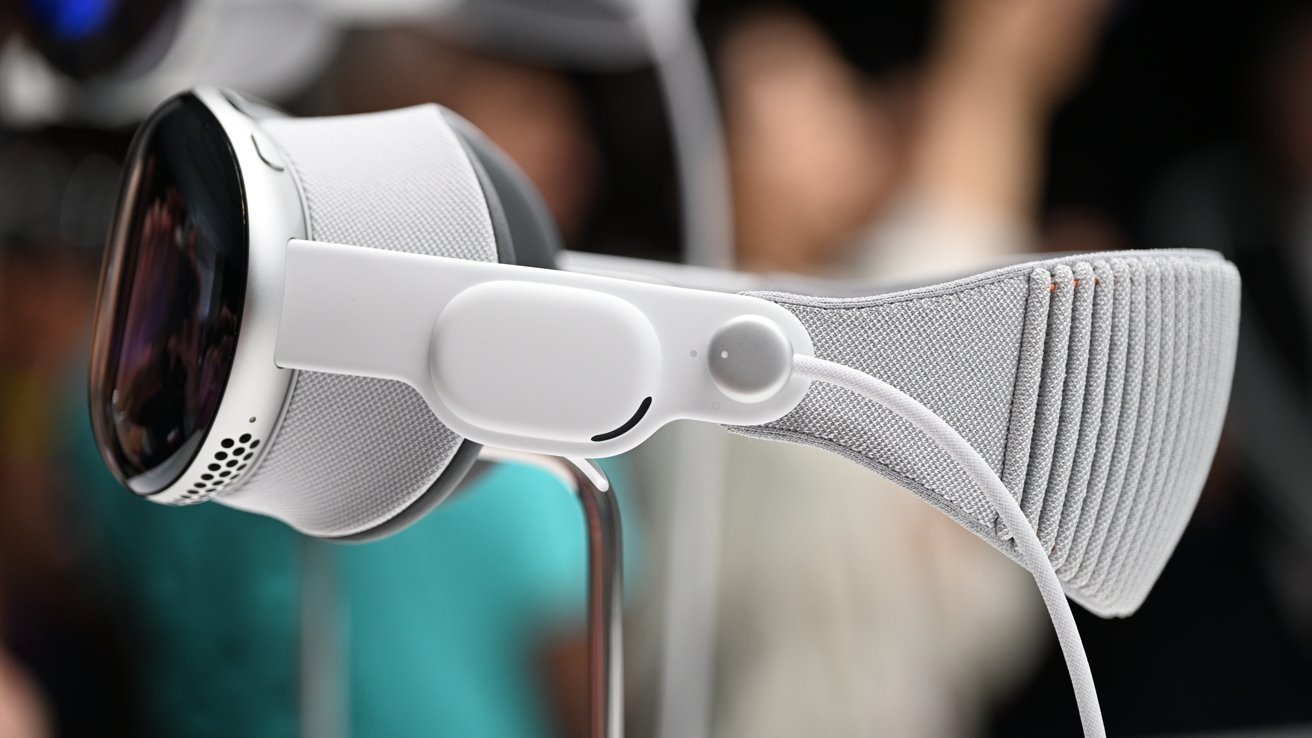Future Apple Vision: What to expect from Apple's next headsets
Apple's follow-up to the Apple Vision Pro could improve upon an already pretty solid design. Here's what's been rumored about Apple's continued pushes into Spatial Computing.

An Apple Vision Pro at an Apple Store
Since the launch of the Apple Vision Pro at WWDC 2023 and the release of the headset in February 2024, Apple has enjoyed some success with its headset. It's been celebrated for its design and how it can help in industries such as medical care.
However, as a $3,500 mixed-reality headset that's still in its first generation, it has also struggled a bit to secure sales.
As with pretty much every product Apple produces, after launch, the rumor mill's attention gravitates towards the next version of the device. Here's what the speculation about Apple's headset follow-up says is on the way.
Double Apple Vision
Apple is never working on only one generation of device. It has the luxury and financial ability to have multiple products in development.
Even in the early days of headset rumors, Apple was said to be working on multiple headset designs. For example, in late 2022, it was said Apple had two headsets in the works beyond the first headset release, as well as the rumored Apple Glass smart glasses.

The consumer Apple Vision may downgrade the displays.
Supposedly under the codename "N602," the second-generational release was said to consist of two variants. One version would provide an improvement over the first Apple Vision Pro to consumers, as a premium option.
The other, the more consumer-grade edition, would be a low-priced alternative, potentially changing the specification to cut costs.
A year later in November 2023, the rumors continued the narrative of there being a premium follow-up with high specifications. A second mass-market edition with a lower price was also expected.
Half the Apple Vision Pro cost
That November 2023 report indicated that the consumer-grade version of the Apple Vision Pro follow-up could end up being a lot cheaper for Apple to make.
While the report doesn't state a price to consumers, the ultimate price tag would depend on what Apple could do to cut the cost of production.

You may see fewer cameras on a future cheaper Apple Vision headset.
It was claimed that Apple aimed to reduce the Bill of Materials down to half of what the Apple Vision Pro costs.
In October, it was proposed the cost could be brought down to between $1,500 to $2,500, thanks to some considerable hardware trimming.
By May 2024, leakers were reiterating the $1,500 to $2,500 price tag.
Apple Vision's specifications diet
To bring the cost down, Apple has to make significant cuts to some of its highest-priced components.
In June 2023, a report proposed that the three highest costs are the camera and sensor array, the use of two Apple Silicon chips, and twin 4K microLED displays.
These cuts could take the form of using fewer external cameras for the sensor array than used in the Apple Vision Pro. Apple could also replace the dual chips for a single Apple Silicon chip, or even an A-series version as used in its iPhone lineup.
The displays could also be switched to slightly lower-resolution versions.
A simpler headband design, the use of AirPods for spatial audio, the loss of the 3D camera feature, and removing automatic interpupillary distance adjustments could also be on the block.
However, while the report offered that the external EyeSight display would remain, the outlet changed its tune by October. Instead, the screen would be removed, saving costs.
Apple Vision may not be self-sufficient
The Apple Vision Pro is known as an all-in-one device, in that it can work independently of other hardware. Unlike earlier VR headsets, it doesn't need to be tethered to a host that can handle most of its processing.
That may not be the case for the next version. As part of the cost-cutting and weight loss for the headset, Apple may need to look to using a host device.

The Apple Vision Pro is tethered to a battery.
In June 2024, a report claimed that the Apple Vision could end up being a tethered piece of hardware, connected to an iPhone or Mac.
For Apple, this would not only cut the cost by reducing onboard processing, but it would also build a "tier" system into the range. While the Apple Vision Pro models could be working on their own, the non-Pro could be the tethered versions.
Next Apple Vision in 2025 -- maybe
The next iteration of the Apple Vision Pro could end up being closer than people think. At least, according to some reports.
In February 2024, Bloomberg offered that there could be at least 18 months from the date of publication until a new headset is introduced. That would put a headset launch in late summer 2025.
However, the report doesn't go into detail about the timing, nor whether it is a hunch or based on external sources.
By June, there were claims that Apple was reaching out to manufacturers of small OLED-on-Silicon panels for a new mixed-reality headset. While Sony is a current supplier for the Apple Vision Pro, Apple had apparently sent a request to its usual display partners LG and Samsung.
The report at the time said that the panels would measure 2 to 2.1 inches in size, larger than the 1.42 inches of the Apple Vision Pro's panels. However, they would also be just half the resolution, meaning they could be used in the consumer-grade version.
As for the second-generation premium model, June also saw claims from a supplier that work had stalled. However, progress on the consumer-grade model was still ongoing.
A weight lifted
While the specifications, features, and pricing of the headset are still largely unknown, one thing that should change is the weight.
Before the release of the Apple Vision Pro, a report claimed the current version was determined to be "too heavy for some users" in testing. Neck strain complaints were apparently raised by testers.

The current Apple Vision Pro design is quite heavy
This was a sentiment shared by AppleInsider itself with its own trial of the device. After an hour and a half of use, "light neck fatigue" was encountered.
The complaints have apparently been taken onboard by Apple, and will be a factor in the production of future headsets.
The next Apple Vision could still leave a hole in your wallet, and may not necessarily offer the same performance as the first headset outing. At least you won't be in as much pain.
Read on AppleInsider

Comments
1— Alan Kay —famous American scientist— uses to say: “The best way to predict the future is inventing it.” That is what Apple does!
2— Before predicting the future… say 5 years in advance… please do the following test.
See yourself in July 2019. Did you imagine that by now… we have Apple Silicon devides? And that we are int 4th versions of them? (If you are honest with yourself… you will admit that you thought we would still be on Intel!)
Did you think that Apple would deliver a complete developed Vision Pro?
Did you think that Apple would deliver… small things… like Emergency SOS by Satellite?
Did you think that Apple would present… Apple Intelligence… with the privacy-protecting Persons Cloud Compute?
I'm sure that… neither you nor me… thought that things in 2019… maybe just one chip with Apple silicon.
After that test… rewrite your article!
Seoncdly, I’d suggest that the emotional appeal of 3D family images taken with the Vision Pro are a killer feature, and should not be removed from a future less expensive model. That feature alone certainly has driven sales.
Now, if they’d just deal with the lack of prism support in optical inserts for double vision customers, I’d be fully satisfied. It should be straightforward to use software to let the customer tweak the image alignment from each 4K screen to provide full functionality for vision impaired customers.
You state this as a fact. And yet the fact is, you have ZERO facts to back this up. NONE. You link to a report from Kuo, who has been all over the map in his assessments about how Vision Pro is doing -- so which Kuo quote do you want to believe? And even his baseless assessment that orders have been cut is based on the totally faulty premise that they were cut vs a "market consensus" for expected sales that doesn't even exist! There has never been a "market consensus" for estimated Vision Pro sales--like Kuo's own quotes, brokerage house estimates have been all over the map. The 700K-800K "market consensus" figure in the Kuo report is a complete fiction and totally made up. I'm sorry, but as an Apple news site, you have a greater responsibility not to be publishing bullshite piled onto a mountain of guano as "fact." No one in their right mind, and certainly not Apple, would expect that a $3500 v1.0 device of an all-new computing platform was going to be a big seller out of the gate.
Who is VP 1.0 for? Think about it: well-heeled early adopters, the wealthy who simply like owning the latest toys plus developers and companies looking to explore and exploit the capabilities and possibilities that this new platform offers. That's a very limited market and entirely expected. The larger market success of Vision Pro was always going to be tied to future iterations of the product at the inevitably lower price points and more mature development of both the hardware and OS that are necessary to attract that bigger market.
Anyone writing off Vision Pro now is obviously ignorant of basic Apple history: it took many years for the Mac to break through from niche computer to larger market success.
It’s clumsy and uncomfortable to wear. It’s too heavy. The face mask thingie connects magnetically and constantly falls off when you pick it up.
But the biggest problem is: there is not much you can do with it. You have your apps, like Mail, but it’s easier and more productive to use your MacBook or iPhone.
Most games are projected flat, on a place - yes, 3D games. Some of them are nice but there’s not a single game that is an instant hit like Beat Saber. The FaceTime avatar is nice but incredibly creepy. I tried it with a coworker who has an AVP as well.
There is no real added value compared to, say, a Meta Quest 3, even with the very useful eye tracking. The content discovery experience is sterile, cold, boring, while the Quest has amazing games and simply ‘knows’ that it is its own medium and not trying to be a new sort of computer for productivity.
Similarly the AVP provides no added value to a phone, desktop or tablet either.
So... given that disastrous beginning, where is Apple Watch today? It is, by many orders of magnitude, the most successful watch in the 200 year history of watches. Not only has it left every other watch brand in the dust, it eclipsed the entire Swiss watch industry in sales years ago. But that didn't happen overnight. It took several YEARS of new models before the Watch was truly independent of the iPhone. And it took several YEARS of new models before a central purpose for Watch evolved that will carry it forward for years to come--a central purpose not considered for v1.0: health tracking. We're still in the early innings of sensor development for health purposes, but sales will absolutely explode when real-time blood pressure and glucose level monitoring are possible, and that's only a matter of time.
If you know anything about Apple history, and clearly you do not, many of its greatest successes, including the Mac, itself, took years to evolve beyond v1.0 into the hit products we now know them to be. Just to be clear: I'm not claiming that Vision Pro is going to be a hit. I can't know that. No one can. But what I can state with absolute certainty is whether it will become a hit or not will take several years of iterations to determine. Apple has been down this road before and--most importantly--has the cash to sustain the continued development that's necessary.
For a first generation product, I am blown away by how refined and useful the Vision Pro is. It is not for everyone, as no product is, but I have no doubt that Apple has a long term vision and road map for this device. For those with a good imagination about where this technology could go, that is exciting.
AVP… where will Apple take it? The R&D cost must be paid. Northrop-Apple or another major vertical? For consumers AVP is mainly for rich couch potatoes without family or friends. Most people want to be social when watching a game or movie. We want to drink a beer and have some snacks.
AVP is tech looking for a market. New hardware is only needed when we know where to use the tech or for testing more concepts.
As a buyer of the first release of Apple Watch, which didn't even earn itself a series number, I don't know whether I would categorize the AVP's future growth potential as being analogous to the Apple Watch. Nobody was talking about a supposed need to cost reduce the Apple Watch Series ? to bring down its price point in ways that could potentially degrade its capabilities. It already had a fairly wide range of pricing options from the reasonable (Aluminum) to the absolutely absurd (Edition). I still found the Series ? very useful as an iPhone companion/remote, full featured watch with alarms and timers, step counter, and a convenient way to catch a glimpse of either, messages, emails, notifications, etc. Subsequent releases of the Apple Watch consistently ratcheted up the performance, number of features, quality of the features, and focused more on personal health management. Connectivity kept getting better too with the addition of LTE support and battery life improved. The trajectory was always up, up, and up, never down. Apple didn't trying to match what others were doing in the same space, they went big and set the high bar for the entire market.
Some of the "get cheap quick" measures that are being bandied about for the Apple Vision Pro are quite the opposite of the trajectories that Apple tends to follow. I suppose you could harken back to the Apple Lisa being in over its head on price that contributed to the motivation that drove the Apple MacIntosh to target a much more reasonable price target while pulling some of the highlights from the Lisa. I don't see a direct analogy with the Apple Vision Pro being the "Lisa" to some unknown and cost reduced "Apple Vision Not-So-Pro." The Lisa had no contemporaries that I'm aware of that it was looking to one-up. With nobody else already in the pool, Apple could afford to take an alternative path with the Lisa concept, even to the point of targeting a much lower price point. The pool was empty at that point for the type of computer Apple wants to build. The Apple Vision Pro isn't jumping into an empty pool. There are already other players in the pool. In typical Apple fashion, Apple was in no mood to play at the same level and the same game the others were already playing. Apple went big with the intent to blow the existing players out of the water on as many fronts as they could. But obviously, there were some things they couldn't dominate just like the MacIntosh couldn't derail the PC and PC clones.
I have a hard time seeing Apple backtracking on the vision they established with the Vision Pro simply to bring the price down. If they took that approach with the iPhone, which was considered way too expensive by the other players already in the market upon its first release, the second release of the iPhone would have had a physical keyboard and cost $300 USD. Apple didn't retreat at all, they just kept on improving the iPhone in every way they could and even grew the price points over time to reflect the far greater capabilities. They kept their foot on the gas. I believe Apple will keep their foot on the gas with Vision Pro and further enhance and improve the product and everything around it. They will keep pushing to leave the competition further behind them by redefining what a VR/AR headset can do, i.e., spatial computing. Apple isn't trying to build a better gaming headset. At some point the other players in this market will realize they either have to try to emulate what Apple is doing or resign themselves to building headsets that aren't going after the same kind of customers Apple is satisfying with its more advanced products that go beyond entertainment and gaming and open up new opportunities in areas like productivity enhancement, healthcare, 3D design, simulation, 3D dynamic and interactive modelling, spatial man-machine interfaces, human-robot collaboration, remote presence, etc.
Finally, one of the very first things you learn in Marketing 101 is that you never want to compete based on price. A race to the bottom is a losers game. It results in scenarios where businesses like gas stations and drug stores have to sell candy, beer, cigarettes, week old hotdogs, and huge tubs of sugary soft drinks to make a profit because their primary business purpose, like selling gasoline or filling prescriptions, is no longer profitable. Bad game to be in.